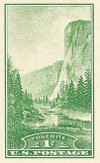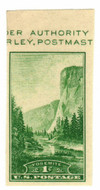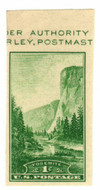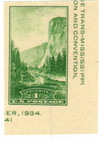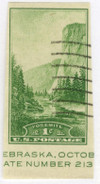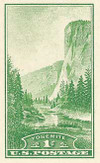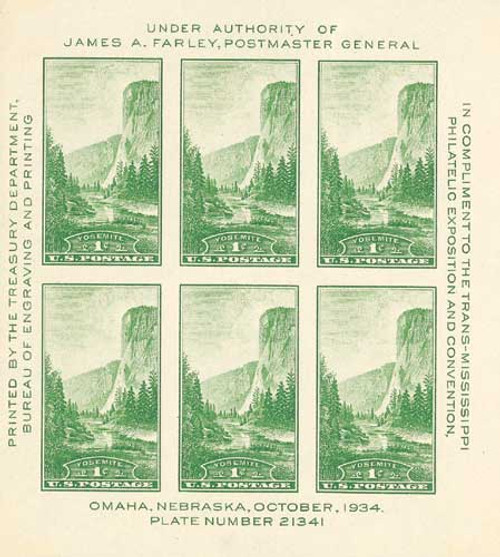
1934 1c Yosemite, imperf single
# 751a - 1934 1c Yosemite, imperf single
$1.25 - $20.00
U.S. #751a
1934 1¢ Trans-Mississippi Philatelic Exposition
Single Stamp
Single Stamp
Issue Date: October 10, 1934
City: Omaha, Nebraska
Printed By: Bureau of Engraving and Printing
Printing Method: Flat Plate
Perforations: Imperforate
Color: Green
City: Omaha, Nebraska
Printed By: Bureau of Engraving and Printing
Printing Method: Flat Plate
Perforations: Imperforate
Color: Green
This stamp was part of a souvenir sheet issued in conjunction with the Trans-Mississippi Philatelic Exposition and Convention held in Omaha, Nebraska. The sheet contained six 1¢ stamps featuring the mountain known as El Capitan. The stamp’s design was one of ten printed for the National Parks series.
Yosemite –
The First National Park
The First National Park
Yosemite National Park is located in the Sierra Nevada mountains, which lie in east-central California about 200 miles east of San Francisco. This national park was established in 1890 and expanded to its present size in 1906. Yosemite is famous for its towering granite mountain peaks, lush valleys, thundering waterfalls, and giant sequoia trees. Most notable among these attractions are: Yosemite Falls, with a drop of 2,425 feet in two segments, the largest falls in North America, and the majestic mountain peaks, Half Dome and El Capitan, which are among the world’s largest monoliths of exposed granite. These attractions bring over four million people to Yosemite each year.
The naturalist John Muir called Yosemite “a landscape... that after all my wanderings still appears as the most beautiful I have ever beheld.” This sentiment was shared by Theodore Roosevelt, who called Yosemite “The most beautiful place on Earth.”
The vast majority of Yosemite’s 1,170 square miles remain pristine. Park officials proudly proclaim that 94.5% of this area remains wilderness.
U.S. #751a
1934 1¢ Trans-Mississippi Philatelic Exposition
Single Stamp
Single Stamp
Issue Date: October 10, 1934
City: Omaha, Nebraska
Printed By: Bureau of Engraving and Printing
Printing Method: Flat Plate
Perforations: Imperforate
Color: Green
City: Omaha, Nebraska
Printed By: Bureau of Engraving and Printing
Printing Method: Flat Plate
Perforations: Imperforate
Color: Green
This stamp was part of a souvenir sheet issued in conjunction with the Trans-Mississippi Philatelic Exposition and Convention held in Omaha, Nebraska. The sheet contained six 1¢ stamps featuring the mountain known as El Capitan. The stamp’s design was one of ten printed for the National Parks series.
Yosemite –
The First National Park
The First National Park
Yosemite National Park is located in the Sierra Nevada mountains, which lie in east-central California about 200 miles east of San Francisco. This national park was established in 1890 and expanded to its present size in 1906. Yosemite is famous for its towering granite mountain peaks, lush valleys, thundering waterfalls, and giant sequoia trees. Most notable among these attractions are: Yosemite Falls, with a drop of 2,425 feet in two segments, the largest falls in North America, and the majestic mountain peaks, Half Dome and El Capitan, which are among the world’s largest monoliths of exposed granite. These attractions bring over four million people to Yosemite each year.
The naturalist John Muir called Yosemite “a landscape... that after all my wanderings still appears as the most beautiful I have ever beheld.” This sentiment was shared by Theodore Roosevelt, who called Yosemite “The most beautiful place on Earth.”
The vast majority of Yosemite’s 1,170 square miles remain pristine. Park officials proudly proclaim that 94.5% of this area remains wilderness.




